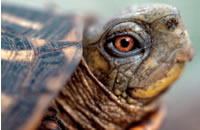Terrapene ornata ornata

Long Term Maintenance and Breeding
of the Ornate Box Turtle
Terrapene ornata ornata
(AGASSIZ, 1857)
by H. ARTNER
Adults â The maximum size reported so far is 15.4 cm carapace length (6.06"; ERNST et al. 1994).
The carapace is rather roundish and wider than in Terrapene carolina.
It is mostly flattened on top and dorsally, and usually there is no vertebral keel present.
There are no serrations at the rear of the carapace.
Its color is brownish to almost totally black with a yellow mid-dorsal stripe.
Light lines are radiating out of the scute centers similar
to T. carolina bauri.
The plastron is equipped with a strong and fully functional hinge
between the pectoral and abdominal scutes thus dividing it into two lobes.
Similarly to the carapace also the plastron has a pattern of radiating
lines on each scute.
Head and legs are heavily spotted with yellow, especially on their dorsal surfaces. Chin and
upper jaw are almost completely yellow. Head coloration might be greenish especially in some
males (see Fig. 1). Each hind foot has four toes (only rarely three).
Adult males very often possess a red iris whereas that of females tends to be more brownish.
The maleâs plastron does not have the concavity of the other species of Terrapene. The first toes of
the hind feet are thickened and turned inwards in order to facilitate hooking into the femaleâs carapace during copulation.
Juveniles â Young are nearly round and flatter than adults. The lines on their carapaces are
faint and there is a yellow dorsal ridge present. The plastron is almost completely dark and the
hinge is not functional at an early age.
Terrapene o. ornata in comparison with T. o. luteola (Fig. 2)
The ground coloration of the carapace of Terrapene ornata ornata is darkish (yellowish in T. o.
luteola). Five to nine radiating lines are present on the second pleural (10 to 16 radiating lines in
T. o. luteola). In older specimens of T. o. luteola the shell often becomes pale greenish to nearly
completely yellow due to pigmentation loss. This never occurs in the nominate subspecies.
Distribution
Terrapene o. ornata occurs from Indiana, Illinois, Wisconsin, and Wyoming southwards to Louisiana and New Mexico. A zone of intergradation with T. o. luteola extends between the Rio Grande
in New Mexico and the New Mexican-Texan border northward to the Canadian River (DODD
2001).
Terrapene o. luteola ranges from the Trans-Pecos regions of Texas and southeastern Arizona
south into Northern Mexico (the states of Sonora and Chihuahua)(Fig. 3).
Material and Methods
Ecology
Multiple papers have been published on this species especially by American authors thus making
Terrapene o. ornata one of the best researched turtle species worldwide. The intensive studying of
these works and the correct implications for captive maintenance can largely improve husbandry
and breeding success.
ARTNER: Long Term Maintenance and Breeding of Terrapene ornata ornata
Figure 2. Comparison of carapace patterns in preserved specimens Figure 3. Locality records of Terrapene ornata.
of Terrapene o. ornata (right) and T. o. luteola (left; a roadkill with (from IVERSON 1992).
fractured shell). (Photo: B. FARKAS).
Habitat
Terrapene o. ornata is a prairie turtle species inhabiting sandy plains, mostly treeless flat prairies
with grass and scattered low brush. The southern subspecies T. o. luteola may as well reach true
desert areas (ERNST et al. 1994).
Seasonal and Daily Activity Patterns
Terrapene o. ornata is active only during daylight hours with the exception of egg laying females
(own observations). Terrapene o. luteola may be active before sunrise and after sunset obviously
thus avoiding the extreme heat during the day (DODD 2001).
Summer â Around the end of March the box turtles are emerging from their hibernation sites
in the southern parts of their range whereas it may last until around mid-April in the northern part
of its range. In the north, turtles start their hibernation around mid-October whereas southern populations do so around mid-November. The two main activity seasons are April to June and
September (ERNST et al. 1994).
Turtles spend most of their daily activity cycle with periods of basking, resting and feeding. In
the morning they leave their nightly retreats and bask for a while before starting to forage. From
mid-morning to mid-afternoon they retreat again before re-starting their activities until dusk.
The hotter it gets during summer the longer the animals rest during midday. Sometimes the
turtles enter freshwater pools during the hottest time of the day.
While animals in the northern range cease their activities during cooler days, the contrary happens in the south where highest activity levels are reached shortly before, during and after thunderstorms (ERNST et al. 1994).
Research done by LEGLER (1960) and BRATTSTROM (1965) indicated that the optimum
body temperatures of adult T. o. ornata were between 24 and 30 °C (75.2 and 86 °F, respectively).
Lower and higher temperatures normally resulted in inactivity.
Read the whole Article in our Association Magazin EMYS
Become a member now !
Za sadržaj svakog komentara je odgovoran autor tog komentara.
| Autor | Thread |
|---|